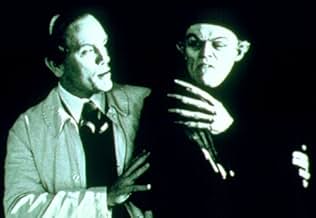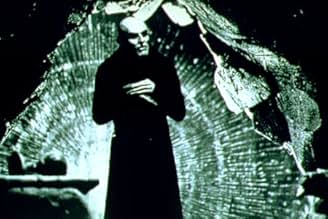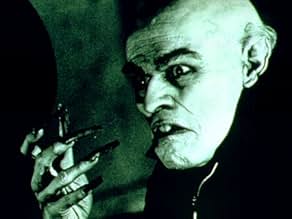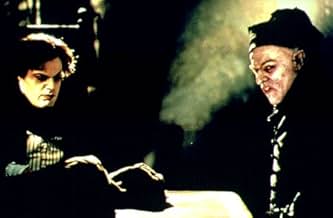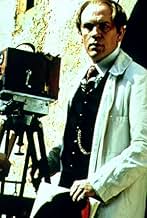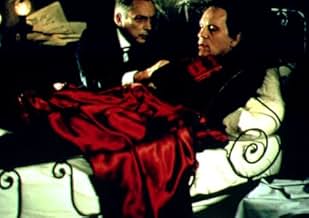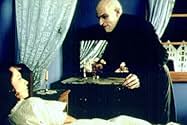Le tournage de Nosferatu (1922) est entravé par sa star Max Schreck, qui prend le rôle d'un vampire beaucoup plus au sérieux qu'il ne semble humainement possible.Le tournage de Nosferatu (1922) est entravé par sa star Max Schreck, qui prend le rôle d'un vampire beaucoup plus au sérieux qu'il ne semble humainement possible.Le tournage de Nosferatu (1922) est entravé par sa star Max Schreck, qui prend le rôle d'un vampire beaucoup plus au sérieux qu'il ne semble humainement possible.
- Nommé pour 2 Oscars
- 16 victoires et 30 nominations au total
- Henrik Galeen
- (as John Aden Gillet)
- Paul - Camera Assistant
- (as Nicholas Elliot)
- Innkeeper
- (as Milos Hlavak)
- Drunken Woman
- (as Sacha Ley)
- Old Woman
- (as Marie Paule Van Roesgen)
Avis à la une
John Malkovich plays famous silent film director F.W. Murnau. This is perhaps the funniest performance of the bunch, especially when he is giving audible instructions to the "actors" while the camera is rolling. Then, there is Willem Dafoe who plays Max Schreck/ the vampire. It is incredibly fun to watch an almost unrecognizable Dafoe play this oddball, Max Schreck. Unfortunately for Murnau, Schreck starts doing what vampires tend to do... bite people. The original photographer dies along with a few others at the mouth of Schreck. After seeing this movie, it is quite easy to see why Dafoe was nominated for best supporting actor at the Oscars. His performance is worth the price of admission.
This is a film which is hard to classify, sense it is a fictional account of an actual film with real people. Yet this horror-comedy does have its moments of wonderful macabre humor along with great performances to help make it an enjoyable movie. A 7 out of 10. I highly recommend watching this as part of a double feature. First, watch Murnau's original 1922 masterpiece, "Nosferatu", then watch "Shadow of a Vampire." You will appreciate "Shadow of a Vampire" a lot more (or maybe vice versa).
This theme makes it of course a must for the ancient horror fans. Lots of footage and trivia of the 1922 masterpiece are shown and that's a real extra value for true cinema buffs ! But of course, this movie reaches far above average thanks to the brilliant performances. A totally disguised Willem Dafoe is absolutely amazing in his role of Max Shreck. It's like looking at the real Schrek...the resemblance is terrific. His appearance (especially the long nails) give you the creeps whenever he's on screen and his voice haunts your head every time he says something. Dafoe never gives away a bad performance but this one is extraordinary. And of course,the same can be said about John Malkovich...his portrayal of director F.W. Murnau is extremely realistic and believable. He plays Murnau as the man who slowly goes insane because he tries to be too perfect. An amazing performance !!
There aren't many shock effects to detect in this movie but that's rather normal, right ? After all, it's more like a costume-drama than it is horror. The lack of exiting scenes is made up by the constant presence of tension and an extremely appropriate atmosphere. Also, a perfect image of Eastern Europe in the 1920's is presented to the audience. All these aspects make a much better movie then just some ordinary slashing and slicing throats. A must see !!
The movie asks us to imagine: What if Max Schreck, the mysterious guy who gave what is still considered one of the best vampire performances ever, did so well because, well, he really was a vampire? The skulking creature, we are to imagine, was finagled into performing in "Nosferatu" for legendary cinema pioneer F.W. Murnau. The story then follows as the crew makes the movie dealing with all sorts of difficulties, not the least of which is the star's habit of snacking on cameramen.
Among the film's many virtues is its portrayal of filmmaking in what was really its dawn as a form of art and commerce. People like me, who have trouble with silent movies may gain an additional appreciation for the work and craft that went in to them, and realize that while they may seem hokey and stylized to us now, they had a beauty and substance that was all their own, and still is.
John Malkovich turns in a great performance as the visionary Murnau (who, while tortured, must be a genius because he always gets it in one take). It is a characteristic Malkovich role, a rationalist given to bouts of fury, and it is as much fun to see him discourse pretentiously on the science and art of the moving image as it is to see him pitch a fit ("Albon, a NATIVE has wandered into my FRAME!").
The core of this movie, however, and deservedly so, is Willem Dafoe's unforgettable portrayal of Schreck. This is not your slick-talking Anne-Rice undead-Vogue kinda vampire. Schreck is the next thing up from a rat, squatting in filth and clicking his claws, and Dafoe is able to inspire laughter as well as fear, and even pathos. He makes us imagine what a rotten existence it must be, to have eternal life alone in a rotting ruin and a withered body. He and Malkovich have some great scenes together, including a sick, hilarious moment when Schreck and Murnau try to hammer out who on the crew may or may not be snacked upon (the cinematographer is necessary, it seems, but the script girl is negotiable).
The movie functions best as a sendup of moviemaking, as the harried Murnau must deal with temperamental actors, unfriendly locals, blood-sucking undead, and other hazards of the movie trade. At one point, Murnau must leave to calm the investors, a scene I really wish had been included. Some of the best moments are those of the age-old creature of the night attempting to take direction and find his "motivation." Everyone is afraid of Schreck, but admire the dedication that keeps him in character all the time (he's a Method actor, explains Murnau, he studied with Stanislavsky). The movie makes its point rather neatly, that filmmakers, and by extension filmmaking itself, have a way of sucking the life and blood out of you. Anyone who has ever had to shoot a movie on location will attest to this.
If I have a complaint about the movie, it is only that after its extreme cleverness, it settles for a somewhat straightforward horror-style denouement. Myself, I would have thought the vampire would end up moving to Berlin and getting an agent, a swimming pool, and a meeting with Ovitz. Still, the movie clearly makes its point: an auteur driven by a mania for artistic perfection can be more of a monster than something that just lives in a cave and drinks blood from your neck.
This is an inventive film that looks at how far art will go to create. The director Murnau seems as driven by the creative process as Shreck is by his lust for blood. This comparison is carried through the whole film until the inevitable showdown between the two drives. The setup itself is fascinating but the comparison between the two men makes it even better.
The film is well shot and uses the different cameras well. It looks really good and mixes bright shots with shadowy darkness really well. It also benefits from a good cast. Malkovich is excellent as the driven director who easily becomes a monster himself but Dafoe is even better. Despite being almost unrecognisable under the make up, Dafoe manages to bring humanity to his monster he also brings some humour without making his a comedy role. Elwes is underused, but Izzard is great as a bad 1920's actor!
Overall this may not inspire interest in everyone but it has a great cast and a good central story. The comparisons drawn between Murnau and Shreck only improve what is already a very enjoyable film.
This is a beautiful film with sumptuous cinematography, wardrobe, and sets. The performances range from static to sensational with an unrecognizable Willem Dafoe stealing the show. Although, there is a lot left to embrace even when he leaves the frame.
It is an offbeat movie to say the least and will be a tough swallow for some. It does wallow in its own craziness but not to the point of distraction. There are some rough inconsistencies to the story but are swept away in the fun and creepiness of it all.
For those willing to imagine the absurd this is quite a conceit to behold. It is all believable in a world gone mad sort of way and it is presented in such a reverential and dutiful way that it can't help but be admired.
Le saviez-vous
- AnecdotesBased in part upon a legend that Max Schreck was in reality a vampire which is why he played the role of Orlok/Dracula so well. Some variations of the legend suggest that Nosferatu le vampire (1922) was the only film Schreck made, though in reality he was already a stage and screen veteran by the time Nosferatu was shot, and would appear in many non-vampiric roles before his death in 1936.
- GaffesThere is a reflection of Count Orlock's head in the mirror moments after a big deal was made about the fact that he cast no reflection in the same mirror (although this is possibly a deliberate nod to Nosferatu le vampire (1922) in which a similar error was made).
- Citations
[Asked what he thought of the book, Dracula]
Max Schreck: It made me sad.
Albin: Why sad?
Max Schreck: Because Dracula had no servants.
Albin: I think you missed the point of the book, Count Orlock.
Max Schreck: Dracula hasn't had servants in 400 years and then a man comes to his ancestral home, and he must convince him that he... that he is like the man. He has to feed him, when he himself hasn't eaten food in centuries. Can he even remember how to buy bread? How to select cheese and wine? And then he remembers the rest of it. How to prepare a meal, how to make a bed. He remembers his first glory, his armies, his retainers, and what he is reduced to. The loneliest part of the book comes... when the man accidentally sees Dracula setting his table.
- Crédits fousCredits end with the sounds of the camera filming and of the phonograph which set the mood for the actors.
- ConnexionsEdited from Nosferatu le vampire (1922)
Meilleurs choix
- How long is Shadow of the Vampire?Alimenté par Alexa
Détails
- Date de sortie
- Pays d’origine
- Langues
- Aussi connu sous le nom de
- La sombra del vampiro
- Lieux de tournage
- Vianden, Luxembourg(Castle interior scenes)
- Sociétés de production
- Voir plus de crédits d'entreprise sur IMDbPro
Box-office
- Budget
- 8 000 000 $US (estimé)
- Montant brut aux États-Unis et au Canada
- 8 293 784 $US
- Week-end de sortie aux États-Unis et au Canada
- 150 171 $US
- 1 janv. 2001
- Montant brut mondial
- 11 155 214 $US
- Durée1 heure 32 minutes
- Couleur
- Mixage
- Rapport de forme
- 2.35 : 1
Contribuer à cette page





